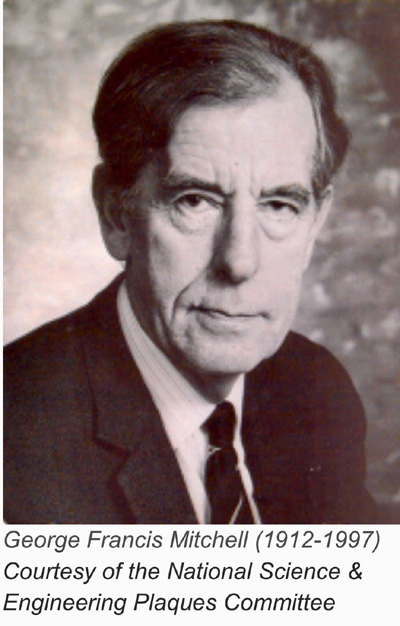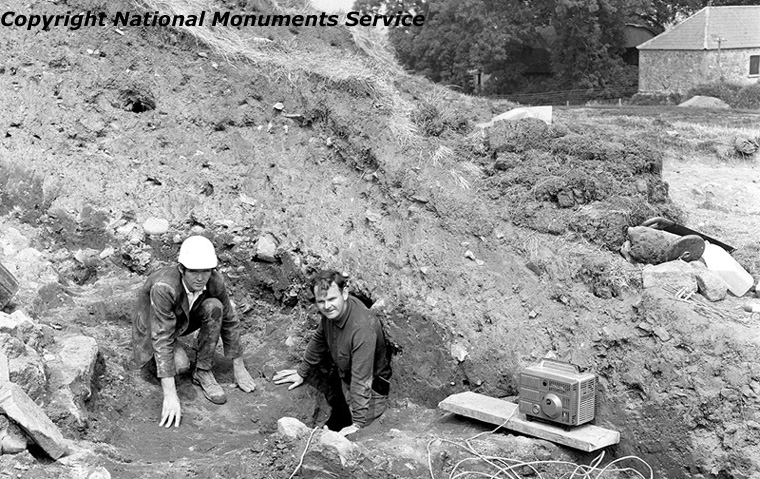George Francis Mitchell (1912-1997)
 Born
in Dublin, Ireland to David William Mitchell and Frances Elizabeth Kirkby, he received
his education at the High School in Dublin and studied Natural Sciences at Trinity College,
Dublin, graduating with a BA. Subsequently, he earned an M.Sc (1935) and M.A. (1937).
Born
in Dublin, Ireland to David William Mitchell and Frances Elizabeth Kirkby, he received
his education at the High School in Dublin and studied Natural Sciences at Trinity College,
Dublin, graduating with a BA. Subsequently, he earned an M.Sc (1935) and M.A. (1937).
In 1934, he assumed the role of assistant to Geology Professor Knud Jessen, conducting field studies on post-glacial sediments in Ireland. While this work marked his early career, his true passion lay in synthesizing various disciplines to understand the Irish natural environment, expanding into botany and archaeology.
He acquired Townley Hall from Trinity College, transforming it into a self-funded study center that facilitated research across diverse fields, notably supporting archaeological investigations at Knowth.
Elected as a Fellow of Trinity College in 1944, he later became a lecturer in Irish Archaeology. In 1965, he ascended to the Chair of Quaternary Studies. Throughout his career, he authored several books and delivered numerous broadcasts.
Books
Frank Mitchell wrote a series of acclaimed books on the Irish natural environment.The Irish Landscape (1976)
My life's work, writes Professor Mitchell, is my interest in the natural history of man in Ireland. And that is what this book is: the result of forty years of work in this field. The Irish landscape divides into four major sections. Firstly the author describes the development of the geological foundations of Ireland and gently stetches the formation of the major elements of the landsurface that still exists.Secondly he devotes a major chapter to the alternating phases of heat and cold that are better known, to laymen, as the Ice Ages, but that geologists refer to as the Pleistocenc. Thirdly Mitchell describes the development of ireland in the period between the melting of the last glaciers some 10,000 years ago and the known arrival of man in the country about 5,500 years ago. Finally he deals with the changes wrought by man on the landscape and, briefly, looks ahead to some emajor possible future changes.
The most important chapters of the book are those dealing with alternating heat and cold, with the development of Ireland between 10,000 and 5,500 years ago and with the pre-Christian peoples. The author draws extensively on his own researches as well as on those of many others, creating a readable and enjoyable synpress of almost half a century of research. Furthermore much of that research was known only to a very small handful of specialists and some of it appeared in little-known papers or in theses.
Purchase at Amazon.com or Amazon.co.uk
The Way That I Followed: A Naturalist's Journey Around Ireland (1990)
In general, his journeys primarily lead him to the hidden corners of Ireland, with a few notable exceptions. Few individuals have traversed as extensively as Mitchell, or endured through so many periods of evolving thoughts, attitudes, and awareness. To his everlasting credit, he has consistently upheld the role of a modern scholar – advocating for his perspective while also embracing new ideas and technology with a mental agility and stamina envied by much younger counterparts.In the realm of Irish landscape studies, Frank Mitchell remains unparalleled; no one comprehends the complete picture better than him. And what an exceptional career he has had! Not many scholars find themselves as sole entities within a major university department. To accommodate his diverse interests, Trinity College established a Chair of Quaternary Studies for him in 1965, a position he held with distinction until his formal retirement in 1979. Fortunately, he has remained actively engaged since then.
In his pursuit of a comprehensive understanding of how our landscape developed, Mitchell delves into various disciplines such as peripheral forest, early geology, archaeology, wine, and art. He shares the story of how he came to embrace these disciplines and integrated them into his overarching quest for understanding. Those of us who started later in our journeys will nod in agreement with his question: "When did you start to work?"
Purchase at Amazon.com or Amazon.co.uk
Reading the Irish Landscape 1997
Co-authored by Frank Mitchell and Michael Ryan, this collaboration giving all the elements of the original The Irish Landscape book, modified, updated and further enhanced by the inclusion of a new narrative of Irish archaeology from the Stone Age to the Norman Invasion. Together they have successfully undertaken the daunting task of giving in one book the story of the shaping of the land from the beginning of time until now, by all tbe varying forces of nature, sea, climate, man and machine. The story takes in the shaping of the crust, the movement of glaciers, the first men and their primitive agriculture, their buildings and their effect on the forests, the growth of bogs, new migrations, the rise of the monasteries of the Early Christians and the castles of conquest, the devastation of war, urban growth, modern agriculture and afforestation, all set against the backdrop of the landscape, arguably one Ireland's most precious resources.Purchase at Amazon.com or Amazon.co.uk
Frank Mitchell Obituary
Published in The Irish Times - December 22 1997Frank Mitchell died peacefully last month after a short illness, aged 85. He led an extraordinarily distinguished, productive and varied life. While a student at Trinity he became a Scholar of the House, a gold medallist in natural sciences (geology and zoology), president of the Phil., editor of TCD and a fine swimmer.
Chance determined his career directions. The Royal Irish Academy had established a committee for quaternary research in Ireland, with Robert Lloyd Praeger as chairman and Tony Farrington as secretary. It invited Knud Jessen, Professor of Botany in the University of Copenhagen, to come to Ireland to study the history of Ireland's plant life as revealed by plant fossils preserved in bogs, using fossil seeds and pollen.
Jessen needed field assistants and Frank was employed through long summers of fieldwork and occasional visits to Copenhagen. Besides fossil plants, there were many opportunities to study archaeological objects found during peat-cutting and to study animal remains such as the extinct giant deer buried under bogs. Tony Farrington, who was also secretary of the academy, became his mentor in glacial geology and landscape, helping to develop Frank's special eye for how landscapes came into being and how they were influenced by man. Arthur Stelfox of the Natural History Museum, another mentor, helped to develop his love of birds and wildlife. His work was an intertwining of archaeology, fossil plants, the understanding of landscape and of its use by man. It is not a fashionable phrase, but he was a great natural historian.
Trinity was an important part of his life: he was a lecturer or professor from 1934 until his retirement in 1979, then a Pro-Chancellor presiding over degree-conferring ceremonies from 1985 to 1987. His early involvement with the Royal Irish Academy continued through his life, culminating with the presidency in 1976-79.
He was president of the Royal Society of Antiquaries of Ireland from 1957-60, while his contribution to conservation was recognised by the presidency of An Taisce, of which he was a founder member, from 1991 to 1993. He was a Boyle medallist of the Royal Dublin Society, together with many other awards. His work has always had Ireland as its focus, but he achieved wide international recognition also. He was a Fellow of the Royal Society, held an honorary doctorate from Uppsala and was President of INQUA (the International Quaternary Association) from 1969-73, delivering his presidential address in New Zealand. He travelled extensively and had a special love for France.
After his retirement he lived at Townley Hall, near Drogheda, until his wife Pic's death, when he withdrew to the too-modestly described "gardener's cottage", where he liked to receive visitors in a sun-porch adorned with potted plants. There his career found a new vigour and direction, in writing a series of books about Ireland's geology, landscape and prehistory, the most recent with Michael Ryan on Reading the Irish Landscapes. The Way That I Followed, dedicated to his friend Elizabeth Fitzpatrick, appeared in 1990 and contained much autobiographical material. He wrote The Great Bog of Ardee with Breeda Tuite and became very interested in Valentia Island in his last years. There his proclaimed leisure activity of "archaeological field walking" reached a high point. Papers still lay before reviewers at his death. He was a great populariser, wellknown as a radio broadcaster with John Quinn as editor, and he appeared on television.
A catalogue of Frank's achievements could be very long, but the small details of his life reveal something of his range. He attended Samuel Beckett's lectures in French and often regretted that he could not now lay hand on his lecture notes. He was a firewarden on the roof of Trinity's Old Library in the war years, for there was a real fear of incendiary bombs. He was a very tough junior dean (he mellowed later). One student who paid a fine by pouring coins through his letterbox found his fine doubled for "insubordinate insolence".
He was Trinity's Registrar when Board Minutes were ceasing to be recorded in longhand. He had much to do with founding the college's modern, professional administration. Many of the older generation will remember his popular crowded lectures in Irish archaeology, always well illustrated by colour slides. When he was president of the Society of Antiquaries, the family lived in a flat above the society's rooms in Merrion Square. A meeting of the society often ended with an invitation upstairs. Frank and Pic were accomplished hosts, and their receptions and his work with the academy created many friendships which helped to link Trinity to the wider Irish society.
He became convinced that a country so dependent on agriculture should teach and research it well. He persuaded the college to buy the Francis Johnston house, Townley Hall near Drogheda, with its 800-acre estate, as a field station to teach agriculture. Ultimately the venture failed because there were not enough students to justify it. The land was sold again but Frank, whose many interests included architecture, was determined to save the house.
He acquired it and it became a study centre, paid for out of his own pocket, which facilitated research in several fields, notably the archaeological investigations at Knowth. Generations of students involved in the Knowth dig lived there and used its laboratory facilities. Without exaggeration he was a great man, one of the greatest Irishmen of his time. He touched many people's lives to their benefit and pleasure. We offer our sympathy to his family, especially his daughters Lucy and Rosamund and his sister Lillias. It is trite but true: we will not see his like again. W.A.W. and G.E.

John Rock and George Eogan at the opening to the passage of the Eastern tomb at Knowth in August 1969
Boyne Valley Private Day Tour
 Immerse yourself in the rich heritage and culture of the Boyne Valley with our full-day private tours.
Visit Newgrange World Heritage site, explore the Hill of Slane, where Saint Patrick famously lit the Paschal fire.
Discover the Hill of Tara, the ancient seat of power for the High Kings of Ireland.
Book Now
Immerse yourself in the rich heritage and culture of the Boyne Valley with our full-day private tours.
Visit Newgrange World Heritage site, explore the Hill of Slane, where Saint Patrick famously lit the Paschal fire.
Discover the Hill of Tara, the ancient seat of power for the High Kings of Ireland.
Book Now
Home
| Visitor Centre
| Tours
| Winter Solstice
| Solstice Lottery
| Images
| Local Area
| News
| Knowth
| Dowth
| Articles
| Art
| Books
| Directions
| Accommodation
| Contact
